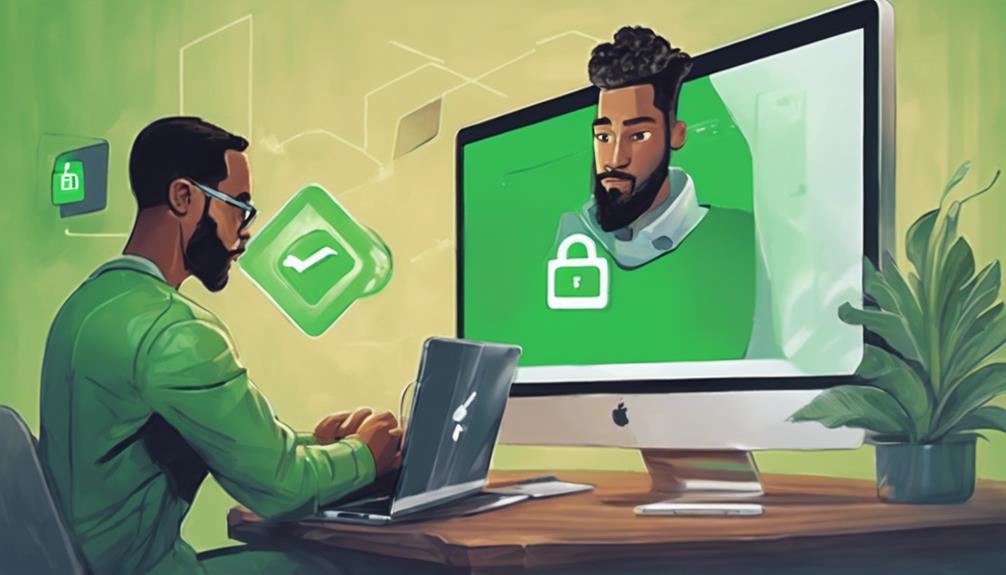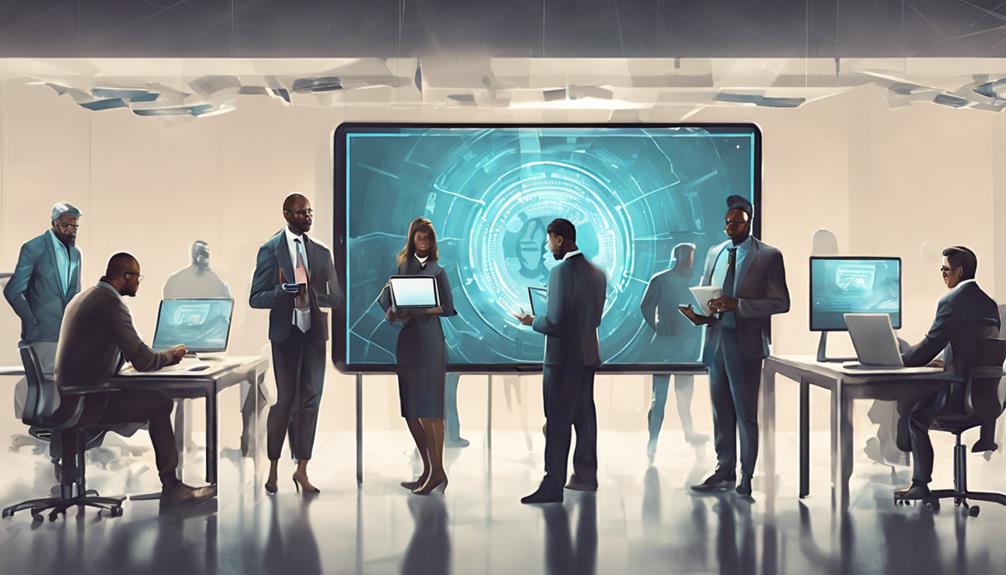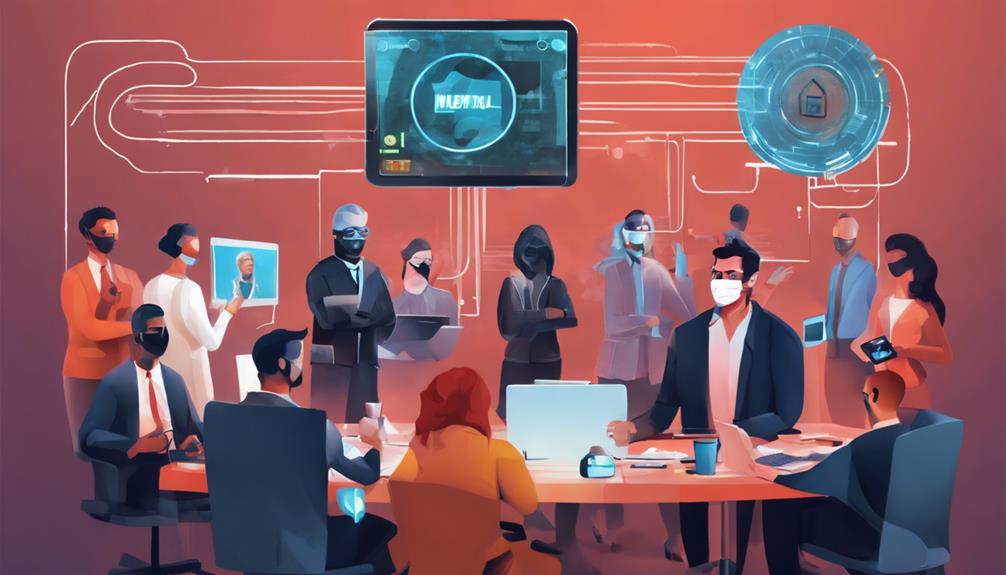Zoom has fortified its security with end-to-end encryption, 256-bit AES encryption, two-factor authentication, advanced chat encryption, waiting rooms, and passcodes, shielding meetings from potential hackers. To enhance security further, set up two-factor authentication, add meeting passwords, utilize waiting rooms, and bolster data privacy measures. Employ secure sign-in methods like SAML, OAuth, and Managed Domains. Recommended settings include enabling two-factor authentication, using waiting rooms, implementing passcodes, and updating software regularly. Address vulnerabilities by ensuring encryption protocols, waiting rooms, and timely security updates. Secure your Zoom meetings by enabling waiting rooms, using passcodes, implementing two-factor authentication, updating software consistently, and considering VPN usage for encrypted communication.
Key Takeaways
- Enable two-factor authentication for added security.
- Utilize waiting rooms to control meeting access.
- Secure meetings with unique passcodes.
- Regularly update Zoom software for latest security features.
- Consider using a VPN for encrypted communication.
Zoom Security Measures
Zoom Security Measures encompass a range of robust encryption protocols and access controls to safeguard the confidentiality and integrity of virtual meetings. One key aspect of Zoom's security strategy is the implementation of end-to-end encryption for secure communication between meeting participants. This means that the content shared during meetings is encrypted using 256-bit AES encryption, ensuring that data transmission remains protected from unauthorized access.
In addition to end-to-end encryption, Zoom offers the option to enable Two-factor authentication, which adds an extra layer of security by requiring users to provide two forms of verification before accessing their accounts. This feature enhances login security and helps prevent unauthorized access to Zoom accounts.
Furthermore, Zoom's Advanced Chat Encryption secures chat sessions using a combination of asymmetric and symmetric algorithms, adding an extra layer of protection to communication within the platform.
Additionally, tools like waiting rooms and passcodes are available to control access and further enhance meeting security, ensuring a safe and secure virtual environment for all participants.
Two-Factor Authentication Setup

Enhancing account security on Zoom can be achieved through the setup of two-factor authentication, which adds an additional layer of protection against unauthorized access. By requiring a second verification step beyond just a password, two-factor authentication helps safeguard Zoom accounts from potential hackers. Users can easily enable this feature within their Zoom settings and link their accounts to a third-party authentication app for the second factor, enhancing the overall security of their accounts.
To highlight the benefits of two-factor authentication, consider the following table:
| Benefits of Two-Factor Authentication |
|---|
| Adds an extra layer of security |
| Helps prevent unauthorized access |
| Safeguards Zoom accounts from hackers |
Enabling two-factor authentication is a recommended security practice to protect not only individual accounts but also the integrity of Zoom meetings. By implementing this additional security measure, users can enhance the protection of their sensitive information and create a safer online environment.
Implementing Meeting Passwords

Implementing meeting passwords adds an essential layer of security to your virtual sessions, controlling access and safeguarding your meetings from unauthorized participants. By setting up meeting passwords for your Zoom meetings, you greatly enhance the security measures in place, ensuring that only invited participants can join the session.
This simple yet effective security feature helps in mitigating the risks associated with unauthorized access, reducing the likelihood of hackers infiltrating your meetings and causing disruptions. When sharing meeting passwords with your attendees, it is important to do so securely to maintain the confidentiality of your sessions.
With meeting passwords enabled, you have better control over who can enter your virtual space, enhancing the overall security posture of your Zoom meetings. Incorporating this security measure is a proactive step towards safeguarding your meetings from potential threats and ensuring a safe and uninterrupted collaboration environment.
Utilizing Waiting Rooms

Waiting rooms provide hosts with the ability to carefully manage the entry of participants into virtual meetings, enhancing control over meeting access and security. By utilizing waiting rooms, hosts can effectively screen participants before granting them access to the main meeting room, thereby ensuring only authorized individuals join the session. This feature acts as a barrier against unauthorized users, hackers, or disruptors seeking to infiltrate the meeting, thereby bolstering the overall security and privacy of Zoom meetings.
Waiting rooms in Zoom allow hosts to control who enters the meeting by admitting participants individually.
Hosts can screen participants before granting them access to the main meeting room.
Waiting rooms help prevent unauthorized users, hackers, or disruptors from joining the meeting.
This feature adds an extra layer of security by ensuring only invited participants can enter the meeting.
Utilizing waiting rooms can enhance the overall security and privacy of your Zoom meetings by allowing you to vet attendees before letting them join.
Enhancing Data Privacy Measures

To enhance data privacy measures during Zoom meetings, it is essential to implement data encryption best practices, ensuring that all information exchanged is securely protected.
User authentication methods play a vital role in verifying participants' identities, minimizing the risk of unauthorized access to sensitive data.
Additionally, configuring secure meeting settings is imperative to maintain a safe and private environment for all participants.
Data Encryption Best Practices
Enhancing data privacy measures within Zoom meetings involves implementing robust data encryption best practices to guarantee the security of sensitive information shared during communications. Zoom security relies on various encryption methods to protect data, such as 256-bit AES encryption for meeting content.
To enhance security further, users can opt for end-to-end encryption, adding an extra layer of protection to their interactions. Cloud recordings and audio transcripts are also stored encrypted, ensuring privacy and security even after the meeting ends.
User Authentication Methods
Securing Zoom meetings extends beyond data encryption best practices to encompass the implementation of robust user authentication methods for enhancing data privacy measures.
Zoom offers a range of authentication methods, including Security Assertion Markup Language (SAML), OAuth, and Password-based options, ensuring secure user verification.
To bolster login security, users can enable two-factor authentication, adding an extra layer of protection against unauthorized access attempts.
Integration with enterprise identity management systems such as Okta and Microsoft Active Directory further fortifies security by centralizing user authentication processes.
OAuth-based provisioning facilitates instant user management within organizations, streamlining administrative tasks.
Additionally, the managed domains feature automates user authentication by adding individuals with specific email domains, simplifying the authentication process for organizations with structured email systems.
Secure Meeting Settings
Implementing secure meeting settings is essential for enhancing data privacy measures during Zoom meetings. To secure your virtual gatherings effectively, consider the following measures:
- Enable waiting rooms in Zoom to vet participants before granting access, reducing the risk of unauthorized individuals joining.
- Use passcodes for all Zoom meetings to add an extra layer of security, ensuring that only intended participants can join the session.
- Admins have the ability to control security settings during meetings, such as locking meetings once all participants have joined, preventing disruptions and unauthorized access.
- Utilize end-to-end encryption in Zoom for secure communication, safeguarding your data from potential interception or breaches.
- Implement additional security measures like using a VPN for encrypted communication, further enhancing the privacy and confidentiality of your Zoom meetings.
Ensuring Secure Sign-In Methods

Utilizing secure sign-in methods such as SAML, OAuth, and password-based authentication is imperative for ensuring the security of Zoom meetings. Two-factor authentication adds an extra layer of protection, requiring users to verify their identity through a second method, reducing the risk of unauthorized access. Integrating enterprise identity management solutions like Okta and Microsoft Active Directory enhances user verification processes, ensuring that only authorized personnel can join meetings.
| Secure Sign-In Methods | Description | Benefits |
|---|---|---|
| SAML | Enables single sign-on for users across multiple systems | Streamlines user access and enhances security measures |
| OAuth | Allows secure authorization without exposing passwords | Enhances user privacy and simplifies login processes |
| Managed Domains | Automatically includes users from specific email domains | Simplifies user management and strengthens security |
Recommended Security Settings Overview

Enhancing the security of Zoom meetings involves configuring recommended security settings to safeguard the virtual environment effectively.
When setting up your Zoom meetings, consider implementing the following security measures:
- Enable two-factor authentication for an additional layer of login security.
- Utilize waiting rooms to screen participants before granting access to meetings.
- Secure your meetings with passcodes to enhance privacy and prevent unauthorized entry.
- Take advantage of the various security settings that administrators can control during meetings to guarantee a safe environment.
- Consider using a VPN for encrypted communication, adding an extra layer of protection to your Zoom sessions.
Addressing Zoom Security Vulnerabilities

Zoom's history of security vulnerabilities, including instances of Zoombombing and unauthorized access to meetings, underscores the importance of addressing potential threats effectively. To combat these issues, Zoom users can implement various security measures. One important step is enabling two-factor authentication, which adds an extra layer of protection to prevent unauthorized access. Additionally, Zoom has improved its security by implementing encryption protocols and regularly updating its software to guarantee data security promptly. Users can further secure their meetings by utilizing features such as passcodes, waiting rooms, and controlling participant access.
To provide a clear overview, the table below outlines key strategies for addressing Zoom security vulnerabilities:
| Security Measure | Description |
|---|---|
| Two-factor authentication | Enhances login security and prevents unauthorized access. |
| Encryption protocols | Safeguards data transmitted during meetings securely. |
| Waiting rooms | Allows hosts to control when participants join the meeting, reducing the risk of unauthorized access. |
Steps to Secure Your Zoom Meetings

To enhance the security of your Zoom meetings, it is important to implement a series of protective measures.
- Enable waiting rooms in Zoom to vet participants before granting access to your meetings.
- Use passcodes for all your Zoom meetings to add an extra layer of security.
- Implement two-factor authentication for your Zoom account to enhance login security.
- Regularly update your Zoom software to patch security flaws and vulnerabilities.
- Consider using a VPN for encrypted communication during Zoom meetings for added privacy.
These steps are vital in safeguarding your virtual meetings from potential security breaches and unauthorized access. By utilizing waiting rooms, you can make sure that only approved participants can join your meetings, preventing unwanted guests from disrupting your discussions.
Additionally, passcodes add a unique identifier to each meeting, reducing the risk of unauthorized entry. Two-factor authentication provides an added level of security by requiring a second form of verification before accessing your Zoom account.
Keeping your Zoom software up to date is essential in addressing any known security issues, while a VPN can encrypt your communication, further protecting your privacy during meetings.
Frequently Asked Questions
Is Zoom Secure From Hackers?
Zoom's security measures continue to evolve to address vulnerabilities and enhance protection against hackers. Users can bolster security by leveraging features like two-factor authentication, waiting rooms, passcodes, and staying vigilant against potential threats like phishing attacks.
Does Zoom Pose a Security Risk?
Despite its popularity, Zoom does pose a security risk due to past incidents of unauthorized access and eavesdropping. Implementing security measures like two-factor authentication and passcodes can bolster meeting security and protect against potential threats.
How Do I Make Sure My Zoom Meeting Is Secure?
To safeguard the security of your Zoom meetings, utilize unique meeting IDs, enable waiting rooms and passwords, avoid public sharing of meeting links, update software regularly, and educate participants on secure conduct, such as refraining from sharing meeting IDs on social media.
How Do I Know if a Zoom Link Is Safe?
To guarantee the safety of a Zoom link, verify its authenticity by checking for a green padlock icon in the URL bar, avoiding unsolicited messages, and using official channels. Implement security features like waiting rooms and passwords for added protection.
Conclusion
In summary, securing your Zoom meetings is vital to protect your data and privacy. By implementing security measures such as two-factor authentication, meeting passwords, waiting rooms, and secure sign-in methods, you can reduce the risk of hackers infiltrating your meetings.
It is important to stay informed about potential vulnerabilities and take proactive steps to guarantee the safety of your online interactions. Remember, prevention is key in safeguarding your virtual meetings from unwanted intrusions.









